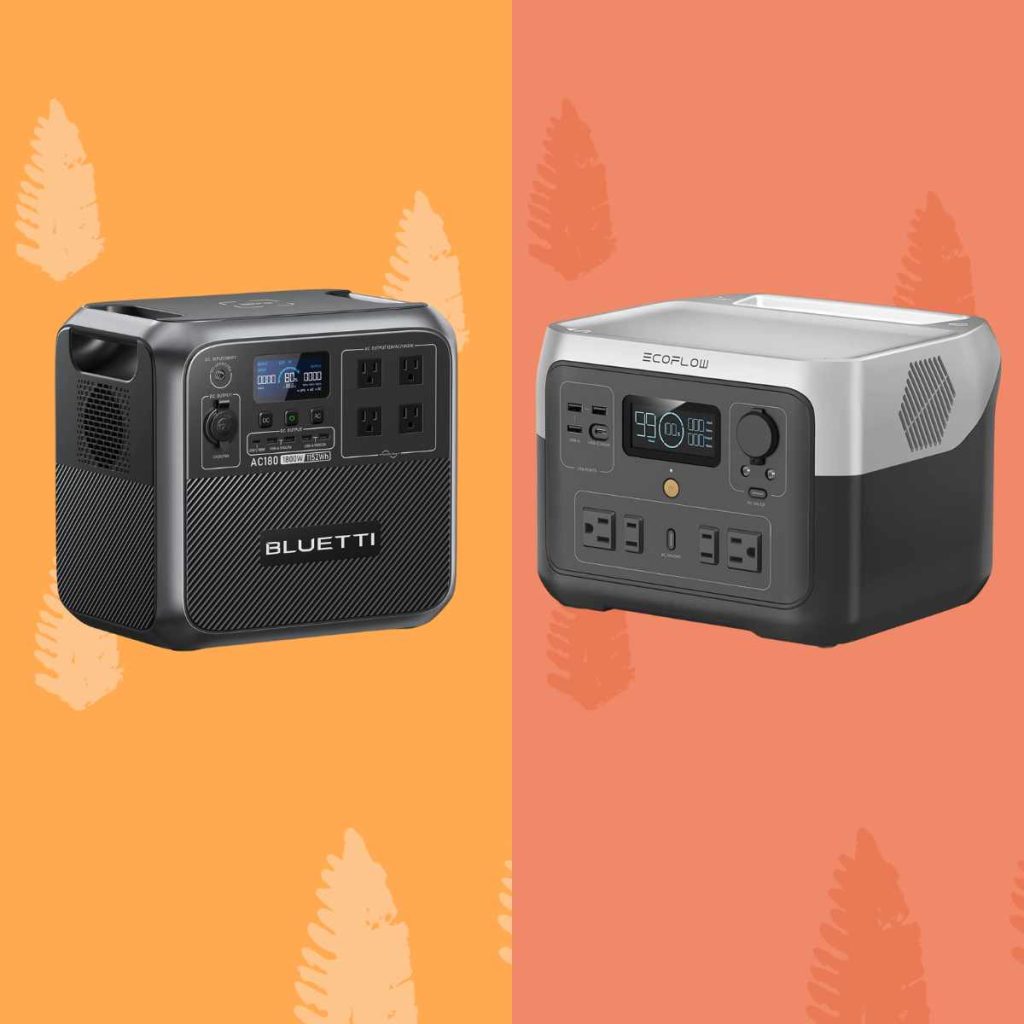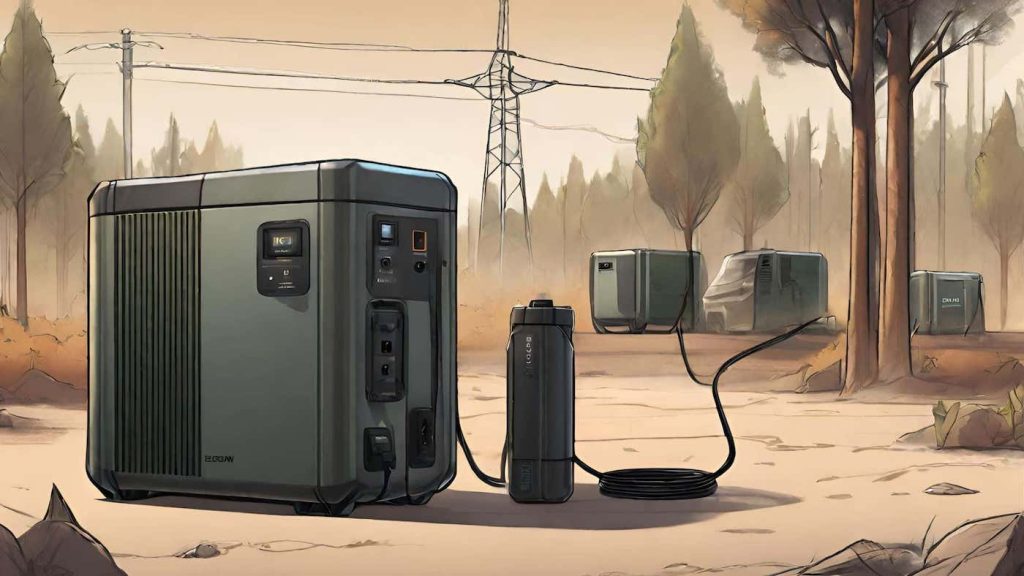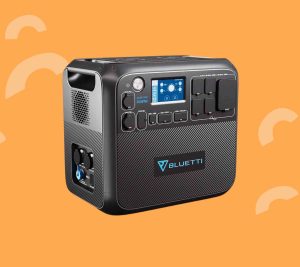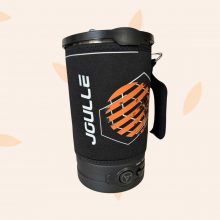
Portable power stations are a great way to have backup electricity when you need it most – for power outages, camping, and most fun of all, living an off-grid van life on the road!
But, with the number of different brands to choose from, it’s a headache to know which portable power station is best. On top of that, these things aren’t cheap!
This article will help you select the best portable power station based on the most important features, including capacity, output, ports, warranty and price.
This article will help you navigate the world of mobile power for two industry-leading brands, Bluetti vs EcoFlow. We’ll compare these two power station brands, and look at features and side-by-side comparisons of 4 different models from each.

Bluetti vs EcoFlow
About Bluetti
Bluetti is a technology company that has built up a solid reputation over the years. In fact, the Bluetti was chosen by the Daily Mail as one of the best solar power stations of 2022.
About EcoFlow
EcoFlow is a leading player in the portable power industry, with a focus on fast charging and expandable batteries. One of their most recognizable features is “X-Stream” technology that can recharge devices in 90 minutes or less!
Feature Comparison
We look at the following features to determine how these portable power stations compare to each other:
Battery Capacity
EcoFlow can deliver more battery capacity than Bluetti, with their Delta Pro capacity expandable up to 25kWh.
Output Power
EcoFlow batteries generally have more output power, while Bluetti provide more surge output.
Weight & Portability
There’s not a big difference between the weight of EcoFlow and Bluetti products. On average, the products have a weight differential of 4 to 12 pounds.
Charging Time
EcoFlow generally recharges faster than Bluetti, with their X-Stream technology able to recharge via AC wall outlet in 90 minutes or less. In comparison, BLUETTI products can take anywhere from 3 to 6 hours to charge via AC wall outlet.
Both Bluetti and EcoFlow products can be charged in a variety of ways, including AC, DC, Solar and at Electric Vehicle (EV) charging stations.
You need to purchase the Bluetti EV station Charger and the EcoFlow EV X-Stream Adapter in order to charge the batteries at EV charging stations.
Outputs & Ports
Bluetti portable power stations generally have a more outlets and ports than EcoFlow. However, BLUETTI and EcoFlow both provide the similar types of outlets and ports, including AC, DC, USB-A, USB-C, RV / Anderson ports and wireless charging pads.
Lithium-Ion Battery Type
Bluetti power stations use premium LiFePO4 batteries, which are safer, more efficient and have a longer lifespan. EcoFlow products use a mix of LiFePO4 and NMC batteries, depending on the model. One of the main criticisms of NMC batteries is that they do not last as long.
Retail Price
There’s not a big difference in pricing between EcoFlow and Bluetti – the cost ultimately depends on the model and features.
Bluetti EB3A vs Ecoflow RIVER 2
Our Choice: EcoFlow RIVER 2
We select the EcoFlow RIVER 2 because of its longer lifespan, faster recharge, and 5-year warranty coverage! The EcoFlow RIVER 2 provides the following features we love:
- EcoFlow RIVER 2 delivers 3,000+ charge cycles, meaning that the battery has a longer life span with more charge/discharge cycles. The Bluetti EB3A has 2,500 charge cycles.
- EcoFlow RIVER 2 can be recharged within 1 hour, using X-Stream technology. The Bluetti EB3A takes anywhere from 4 to 8 hours, depending on the charging method.
- EcoFlow RIVER 2 features a best-in-class LiFePO4 lithium battery, considered safer and less likely to overheat than Nickel Manganese Cobalt (NMC) batteries. The Bluetti EB3A also uses LiFePO4 tech.
- EcoFlow RIVER 2 includes 5 years of warranty coverage, providing extended coverage in case of malfunction. The Bluetti EB3A only has a 2 year warranty.
Comparison Chart: BLUETTI EB3A vs Ecoflow RIVER 2
| FEATURES | BLUETTI EB3A | ECOFLOW RIVER 2 |
| Capacity | 268Wh | 256Wh |
| Battery | LiFePO4 | LiFePO4 |
| Charge Cycles | 2,500 | 3,000 |
| AC Charging Time | 5 hours | 1 hour with X-Stream |
| Solar Charging Time | 4 to 8 hours | 3 hours |
| Output | 600W (1,200 Surge) | 600W |
| Weight | 6.6 lbs | 7.7 lbs |
| Outlets / Ports | 6 total outlets / ports, including AC, DC, USB-A, USB-C, and Wireless | 6 total outlets / ports, including AC, DC, USB-A, and USB-C |
| Warranty | 2 years | 5 years |
| Reviews | – Bluetti Website: 4.9 out of 5 stars – Google Reviews: 4.3 out of 5 stars – Amazon Reviews: 4.3 out of 5 stars | – EcoFlow Website: 4.9 out of 5 stars – Google Reviews: 4.4 out of 5 stars – Amazon Reviews: 4.4 out of 5 stars |
Bluetti EB55 vs Ecoflow RIVER 2 Max
Our Choice: EcoFlow RIVER 2 Max
We love the EcoFlow RIVER 2 Max because it delivers super fast X-Stream 1-hour recharge, a LiFePO4 battery, 3,000+ charge cycles, 1,000-watts of continuous output, and lighter weight. The EcoFlow RIVER 2 Max provides the following features:
- EcoFlow RIVER 2 Max has 3,000 charge cycles, extending the overall life span of the power station. The Bluetti EB55 has 2,500 charges.
- EcoFlow RIVER 2 Max recharges within 1 hour using their proprietary X-Stream technology. The Bluetti EB55 takes 3 to 4 hours to recharge, depending on the method.
- EcoFlow RIVER 2 Max has 1,000-watts of output so that you can simultaneously power more devices. The Bluetti EB55 has 700-watts of output.
- EcoFlow RIVER 2 Max is lightweight and easier to transport, weighing a little more than 13 pounds with an ergonomically designed, adjustable carry handle. In comparison, the Bluetti EB55 weighs 16 and 1/2 pounds.
- EcoFlow RIVER 2 Max is covered by a 5-year manufactures warranty to provide more technical support over the life of the device. The Bluetti EB55 only has a 2 year warranty.
Comparison Data: BLUETTI EB55 vs Ecoflow RIVER 2 Max
| FEATURES | BLUETTI EB3A | ECOFLOW RIVER 2 |
| Capacity | 537Wh | 512Wh |
| Battery | LiFePO4 | LiFePO4 |
| Charge Cycles | 2,500 | 3,000 |
| AC Charging Time | 3 to 4 hours | 1 hour with X-Stream |
| Solar Charging Time | 3 to 4 hours (200W max solar input) | 3 hours (220W max solar input) |
| Output | 700W (1,400W surge) | 1,000W |
| Weight | 16.5 lbs | 13.3 lbs. |
| Outlets / Ports | 13 total: including AC, DC, USB-A, and USB-C | 11 total: including AC, DC, USB-A and USB-C |
| Warranty | 2 years | 5 years |
| Reviews | – Bluetti: 4.8 out of 5 stars – Google: 4.7 out of 5 stars – Amazon: 4.4 out of 5 stars | – EcoFlow: 4.8 out of 5 stars – Google: 4.2 out of 5 stars – Amazon: 4.6 out of 5 stars |
Bluetti AC200P vs Ecoflow DELTA Max 2000
Our Choice: BLUETTI AC200P
We choose the BLUETTI AC200P for its superior LiFePO4 battery, 3,500+ charge cycles to 80%, and 17 total outlets and ports. The BLUETTI AC200P provides the following features that the EcoFlow Delta Max 2000 does not:
- It’s built with premium LiFePO2 lithium technology, which is more stable and longer lasting than NMC batteries.
- It has a much longer life span, with 3,500 charge cycles compared to only 800 for the EcoFlow Delta Max 2000.
- It provides 17 outputs to plug into, including AC, DC, USB-A, USB-C and wireless charging.
- It’s covered by a 4 year warranty for peace of mind in case of product defects.
Comparison Data: BLUETTI AC200P vs Ecoflow DELTA Max 2000
| Bluetti AC200P | EcoFlow DELTA Max 2000 | |
|---|---|---|
| Capacity | 2,000Wh | 2,016Wh |
| Battery Type | LiFePO4 | NMC |
| Life Cycles | 3,500+ charge cycles to 80% | 800+ charge cycles to 80% capacity |
| AC Charging Time | 3-4 hours | 1.8 hours with X-Stream |
| Solar Charging Time | 3-6 hours with two 400W solar panels | 3-6 hours with two 400W solar panels |
| AC Output | 2,000W (4,800W surge) | 2,400W (5,000W Surge) |
| Weight | 60.6 lbs | 48 lbs. |
| Outlets / Ports | 17 total outlets / ports, including AC, DC, USB-A, USB-C, Wireless and RV | 15 total outlets / ports, including AC, DC, USB-A, USB-C |
| Warranty | 4-years | 2-years |
| Reviews | 1,156+ Customer Reviews – Bluetti: 4.9 out of 5 stars – Google: 4.7 out of 5 stars – Amazon: 4.4 out of 5 stars | 1,200+ Customer Reviews – EcoFlow: 4.8 out of 5 stars – Google: 4.7 out of 5 stars – Amazon: 4.6 out of 5 stars |
BLUETTI AC200MAX vs EcoFlow Delta Max
Our Choice: BLUETTI AC200MAX
We choose the BLUETTI AC200MAX because it has more capacity, a superior LiFePO4 battery, more charge cycles and a longer warranty period.
- BLUETTI AC200MAX has more capacity, starting at 2048Wh and expandable up to 8192Wh by adding extra battery packs. The EcoFlow Delta Max starts at 2016Wh, and expands up to 6000Wh.
- BLUETTI AC200MAX uses a superior LiFePO4 battery, known for stability and longevity, while EcoFlow Delta Max runs on NCM batteries, which typically have a much shorter lifespan.
- BLUETTI AC200MAX battery delivers 3,500 charge cycles, which is the number of charge and discharge cycles that battery can provide before its power starts to decrease. Whereas, the EcoFlow Delta Max provides 500 to 800 charge cycles, much less in comparison.
- BLUETTI AC200MAX has 16 total outlets and ports, while EcoFlow Delta Max has 15 total, including AC, DC, USB-A and USB-C ports.
- BLUETTI AC200MAX comes with a longer 48-month warranty, while EcoFlow Delta Max offers a 24-month warranty coverage.
| Features | BLUETTI AC200MAX | EcoFlow Delta Max |
|---|---|---|
| Capacity | 2048Wh (expandable to 8192Wh) | 2016Wh (expandable to 6kWh with extra batteries) |
| Battery Type | LiFePO4 | NCM (Lithium Nickel Cobalt Manganese Oxide) |
| Charge Cycles | 3,500 | 500 to 800 |
| AC Charging Time | 4.5 hours | 1.8 hours with X-Stream AC fast charging |
| Solar Charging Time | 2.7 to 5 hours | 2.5 hours |
| AC + Solar Charging Time | 2 hours | n/a |
| Dual AC Charging Time | 2.5 hours | 65 Mins |
| AC Output | 2200W continuous | 2400W continuous (5000W surge) |
| AC Input | 500W Max | Max 1800W, 15A |
| Solar Input | 900W Max | 11-100V, 13A, 800W Max |
| Weight | 61.9 Pounds | 48 pounds |
| Outlets / Ports | 16 Total: 5 x AC outlets 2 x USB-A 5V/3A 2 x USB-A 18W 2 x 100W PD USB-C 2 x 12V/10A DC port 2 x wireless chargers 1 x 12V/30A DC port | 15 Total: 6 x AC outlets 2 x Fast Charge USB outlets 2 x USB-A 2 x 100W PD USB-C 2 x DC ports |
| Warranty | 48 months | |
| App Control | Yes | Yes |
| Internet Connectivity | Yes | Yes |
| Special Features | LCD Touchscreen |
Bluetti AC300 + B300 vs Ecoflow DELTA Pro
Our Choice: EcoFlow Delta Pro
Both of these models give you a lot of power, longevity and superior LiFePO4 technology.
- EcoFlow Delta Pro has a lot more battery capacity that’s expandable up to 25,000Wh, making it a backup solution for the entire home. The Bluetti AC300 + B300 has a maximum 12,299Wh capacity.
- EcoFlow Delta Pro can be recharged within 1.8 to 2.7 hours. The Bluetti AC300 + B300 recharges within 1.5 to 3 hours.
- EcoFlow Delta Pro has higher output power of 3,600-watts, with 7,200-watts surge power. The Bluetti AC300 + B300 has 3,000-watts output, with 6,000-watts surge power.
- On the downside, the Delta Pro is heavier, more expensive, and has less outlets and ports to plug into.
Comparison Data: BLUETTI AC300 + B300 vs Ecoflow DELTA Pro
| Features | Bluetti AC300 + B300 | EcoFlow DELTA Pro |
|---|---|---|
| Capacity | 3,072Wh expandable up to 12,288Wh | 3,600Wh expandable up to 25,000Wh |
| Battery Type | LiFePO4 | LiFePO4 |
| Charge Cycles | 3,500 | 3,500 |
| AC Charging Time | 1.5 – 3 hours (3,000W AC charging) | 2.7 hours (1,800W) or 1.8 hours (3,000W) |
| Solar Charging Time | 4-9 hours | 4-8 hours (3 x 400W solar panels) |
| AC + Solar Charging Time | 2 hours | n/a |
| AC Output | 3,000W (6,000W Surge) | 3,600W (7,200W Surge) |
| Weight | AC300 – 33.1 lbs.; B300 – 28.6 lbs. | 99 lbs. |
| Outlets / Ports | 16 total: including AC, DC, RV, USB-A, USB-C, Wireless | 12 total: including AC, DC, USB-A, USB-C, and Anderson port |
| Warranty | 4 years | not specified |
| Reviews | – Bluetti: 4.9 out of 5 stars – Google: 4.4 out of 5 stars – Amazon: 4.3 out of 5 stars | – EcoFlow: 4.9 out of 5 stars, – Google: 4.8 out of 5 stars – Amazon: 4.6 out of 5 stars |
Quick Comparison Table
| Features | Bluetti | EcoFlow |
|---|---|---|
| AC and DC outputs | Yes | Yes |
| USB-A ports | Yes | Yes |
| USB-C ports | Yes | Yes |
| Wireless charging ports | Some models (1) | Some models (2) |
| Solar charging | Yes | Yes |
| Type of battery | LiFePO4 | LiFePO4 / NCM |
| Expandable | Some models (3) | Some models (4) |
| Smart app connectivity | Some models (5) | Yes |
| Detailed LCD display | Yes | Yes |
| Fast charging with AC + Solar | Some models (6) | Yes |
(1) BLUETTI models that offer a wireless charging pad: BLUETTI EB55, BLUETTI EB70S.
(2) EcoFlow models that offer a wireless charging pad: EcoFlow Delta 1300, EcoFlow River 600.
(3) BLUETTI models that have expandable batteries: BLUETTI AC300, BLUETTI AC200P, BLUETTI AC200, BLUETTI EP500/Pro.
(4) EcoFlow models that have expandable batteries: EcoFlow Delta Pro.
(5) BLUETTI models that offer app connectivity: BLUETTI AC180, BLUETTI EB3A, BLUETTI AC500 + B300S.
(6) BLUETTI models that offer fast charging AC + Solar: BLUETTI EB3A, BLUETTI AC200P.
Bluetti Pros and Cons
| PROS | CONS |
|---|---|
| LiFePO4 Technology. All BLUETTI products use the superior Lithium Iron Phosphate (LiFePO4) batteries, which are reliable and stable in comparison to NMC. | Average AC Charging Speed. Around 400-600W, which is considered average compared to other models. |
| More Charge Cycles. BLUETTI power stations deliver an average of 3,500 charge cycles, which equal years of additional life span. | Cooling Fan Can Be Noisy. Some users report that the BLUETTI inverter fan is loud, especially when the power station is fully charged or operating in bypass mode. |
| Wide Selection of Outputs and Ports.BLUETTI provides a wide selection of outputs and ports to plug into, including AC, USB, DC, RV and wireless charging ports. | |
| Durable, Rugged Design. BLUETTI products are made of tough flame-retardant ABS plastic and aluminum. | |
| Comes with Standard Connectors. BLUETTI industry standard connector cables include MC4, XT60, and XT90. | |
| Supports Pass-Through Charging. BLUETTI portable power stations can simultaneously power devices while also being charged. | |
| Pure Sine Wave Power. BLUETTI products deliver pure sine wave to ensure efficient and safe charging. |
Bluetti Product Line
Bluetti Customer Support
- Email: [email protected]
- Phone: +1 800-200-2980
EcoFlow Pros and Cons
| PROS | CONS |
|---|---|
| Expandable Capacity. EcoFlow battery capacity can be increased on many of their devices. | Loud Fans. Users report that the fans on some models can be loud. |
| Super Fast Charging. Some EcoFlow power stations have super high-speed charging AC charging in 90 minutes. | Pricey Expansion Batteries. Expansion batteries can be expensive, although cheaper than buying a new power station. |
| Wide Selection of Outputs and Ports. BLUETTI provides a wide selection of outputs and ports to plug into, including AC, USB, DC, RV and wireless charging ports. | Inferior Battery Technology. Some EcoFlow machines use LiFePO4 batteries, while others use NCM batteries which do not last as long. |
| Provides Pure Sine Wave. EcoFlow power stations deliver pure sine wave for efficient and safe charging. |
EcoFlow Product Line
EcoFlow Customer Support
- Email: [email protected]
- Phone: +1 (800)-368-8604
Important Factors to Consider
1. Battery Capacity:
How much energy can it store?
The capacity, measured in watt-hours (Wh), tells you how much electricity a portable power station can store in the battery. For example, you’ll see numbers like “250Wh”, “1000Wh”, “2000Wh” or even “25000Wh” associated with different power stations, and this tells you how much total power the machine can store.
If you need to power large appliances or run devices for extended periods of time, you’ll need a power station with higher capacity of 2000Wh or more. If your needs are minimal, and you just need power for something like a smartphone or laptop, you can get a power station with less capacity around 250Wh to 500Wh.
2. Output Power:
How much power can it deliver?
The output, measured in watts (W), indicates how much power the station can provide at once. If you have devices that require a lot of power, like an space heater, refrigerator or a power tool, you’ll need a power station with a higher output.
3. Portability & Weight:
How easy it is to carry?
The size and weight of the power station are important, especially if you need to be able to easily move your portable power station around. Smaller, lighter power stations are great for camping, but they also may have lower capacity and output. Bigger, heavier portable power stations have higher capacity and charging capability, but they often weigh 50 pounds or more.
4. Charging Options:
How can it be charged?
The power stations can be charged in multiple ways. All can be charged by AC wall outlet or 12V DC outlet. Many are also compatible with solar panels or electric vehicle charging stations.
5. Outputs & Ports:
What can I plug into it?
You should anticipate types of ports you need on your power station. These are what you plug your devices into. Most power stations offer a mix of AC, DC, and USB-A / USB-C ports. Newer models also may offer fast-charge USB-C ports and wireless charging.
6. Lithium-Ion Battery Type:
What type of lithium battery cell does it have?
The type of battery used in a power station is super important because it will directly impact everything from performance and safety to how long the power station will last. Lithium-ion batteries are the most common, and there are several types you’ll have to choose from.
Lithium iron phosphate (LiFePO4) batteries are currently considered the best, because they are safer and can last for up to 10 years with proper maintenance, often delivering 3,500+ charge cycles to at least 80% power which equates to 8 to 10 years of daily use.
NCM lithium batteries on the other hand, but they are more prone to overheating and have a shorter life cycle, usually providing about 800 charge cycles to at least 80% power, which equates to about 3-4 years of daily use.
7. Price:
What’s the cost?
Next, consider your budget. Higher-capacity power stations with more features tend to be more expensive, but there are also many affordable options available that offer good performance for the price.
8. Recharge Speed:
How long does it take to charge?
Ideally, the portable power station should offer some sort of fast-charging option, because the longer a power station takes to charge, the longer you will be without access to power. Also, it’s important to know if the device offers pass through charging, which allows you to charge devices simultaneously while you’re charging the portable power station.
FAQs
What is a power station?
A power station, also known as a portable power station or a solar generator, is a device that stores electricity that can be used to power all sorts of electronic devices and appliances. It’s a convenient and eco-friendly way to generate electricity for your everyday needs without being dependent on the electrical grid.
What are BLUETTI and EcoFlow?
BLUETTI and EcoFlow are two popular brands that specialize in portable power stations and solar panels. They each offer a range of products that differ in battery capacity, power output and price to cater to various needs.
What is the difference between BLUETTI and EcoFlow?
BLUETTI and EcoFlow primarily differ in terms of lithium battery technology, solar efficiency, inverter and charging speeds. BLUETTI uses superior LiFePO4 batteries in all its products and generally has larger solar input, while EcoFlow delivers faster charging speeds and more powerful inverters.
What are the differences in battery capacity between Bluetti and EcoFlow power stations?
EcoFlow power stations can provide more battery capacity, depending on the model you choose. For example, the EcoFlow DELTA Pro capacity expands to 25kWh, while the Bluetti AC300 + B300 maxes out at around 12kWh.
What are the dimensions and weight of Bluetti EB55?
The BLUETTI EB55 portable power station weighs 16.5 lbs (7.5 kg) and has dimensions of length 10.9″ x width 7.8″ x height 7.9″.
What is the battery capacity of Bluetti EB55?
The BLUETTI EB55 portable power station has a battery capacity of 537Wh (watt-hours).
What is the battery type used in Bluetti Eb55?
What is the battery capacity of the Ecoflow Delta 2?
The EcoFlow Delta 2 has starting battery capacity of 1024Wh (watt-hours), and can be expanded up to 2048Wh by adding the DELTA 2 Smart Extra Battery.
How many devices can the EcoFlow Delta 2 charge simultaneously?
The EcoFlow Delta 2 portable power station can charge up to 13 devices simultaneously, including refrigerators, power tools, and medical equipment, thanks to its massive 2016Wh capacity and 6 AC outlets.
Conclusion
EcoFlow and Bluetti both offer high-quality portable power stations to suit to a variety of power needs. Each brand has its strengths and weaknesses.
EcoFlow stands out with super fast charging, high capacity and expandable batteries, while Bluetti impresses with its top of the line battery technology, hardcore construction, abundance of port options and silent operation.
If you are planning to backup your entire house and need lots of capacity combined with the ability to expand your personal power grid as needed, EcoFlow may be the best option.
If you need to bring your power on the road where it will encounter extreme temperatures, and plan on connecting a devices that require diverse ports, Bluetti may be the best for you.
The choice between the two will depend on your specific requirements, budget, and personal preference. Regardless of your choice, both brands will deliver reliable and efficient power solutions that can make your life easier and more convenient.
Related Posts:
- Ecoflow vs Jackery: A Comprehensive Features Comparison
- Jackery Vs Goal Zero: Which Eco-Friendly Power Source Is Right For You?
- EcoFlow Delta 1300 Review: An Eco-Friendly Portable Solar Power Station for Camping
- EcoFlow RIVER Pro Review: More Power, Faster Charging, and UPS Functionality
- BLUETTI EB3A Review: The Ultimate Solution for Your Outdoor Power Needs
- Jackery vs BLUETTI: Which Portable Power Station is Right for You?
EcoFlow RIVER 2

What sets the RIVER 2 apart is its fast charging capability, recharging in as little as 1 hour with an AC wall outlet and 2.3 hours with a 110W solar input. Weighing just 7.7 lbs and featuring a built-in handle, this 256Wh portable power station is perfect for off-grid adventures.
Product Brand: EcoFlow
4.5
Pros
- Best-in-class LiFePO4 lithium battery with 3,000+ charge cycles
- High Power Output that can support AC devices up to 600W
- Fast Charging and can fully recharge in under 1.5 hours
- Includes a 5-year warranty
Cons
- 1lbs heavier than the Bluetti EB3A
- No built-in LED light
- Only provides one Quick Charge USB-C port
BLUETTI EB55

The BLUETTI EB55 is a compact and powerful portable power station that delivers 537Wh battery capacity, 13 outputs, and multiple inputs. It is designed to provide off-grid power for various electronic devices, making it suitable for outdoor activities, road trips, camping, and as a backup power source.
Product Brand: Bluetti
4.4
Pros
- Provides 13 outputs and ports, including AC, DC, USB-A, and USB-C
- Supports dual charging by AC + AC and AC + Solar
- Powerful 700-watt AC output
- Compact and Portable, weighing 16.5 lbs (7.5 kg)
- Multiple Outputs allows users to charge and power multiple devices simultaneously
Cons
- The all-Plastic enclosure may not feel as robust
- Limited Capacity for serious users
- No Built-in LED Light
BLUETTI AC200P

The BLUETTI AC200P is a powerful and versatile portable power station that combines a 2kW inverter with a 2kWh battery, offering a dense power solution suitable for various applications, including off-grid adventures, camping, and as a backup power source.
Product Brand: Bluetti
4.8
Pros
- High Power Output: The AC200P provides a substantial 2000W AC pure sine wave inverter, allowing it to power a wide range of devices and appliances.
- Multiple Outputs: It offers 17 output ports, providing support for charging and powering multiple devices simultaneously.
- Solar Charging: The power station is compatible with solar panel charging, offering an eco-friendly and sustainable power solution.
Cons
- Weight: At 60 pounds, the AC200P is relatively heavy, which may affect its portability for some users.
- Cost: It is noted to be more costly than a 2000W gas generator, which may be a consideration for budget-conscious users.
- Customer Service: Some reviews mention concerns about BLUETTI's customer service, citing a low Better Business Bureau rating.
Ecoflow RIVER 2 Max

The EcoFlow River 2 Max features a sturdy design with a large handle for easy portability. It has a 512Wh battery capacity and delivers up to 500W of power, with the ability to surge up to 1000W. The unit weighs 13.4 lb (6kg) and is designed for durability, with active cooling through built-in fans. It offers various charging options, including AC, car charger, USB-C, and solar power
Product Brand: EcoFlow
4.6
Pros
- Expandable capacity by connecting additional lithium batteries.
- Offers fast charging capabilities to 100% in about 90 minutes.
- X-Boost mode allows for surges up to 1000W.
Cons
- Limited power output for larger appliances like air conditioners and space heaters.
- Does not support wireless charging.






